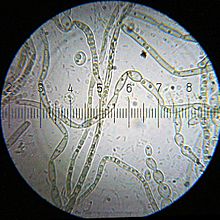- Mildew
-
Mildew refers to certain kinds of molds or fungi.
In Old English, it meant honeydew (a substance secreted by aphids on leaves, formerly thought to distill from the air like dew), and later came to mean mildew in the modern sense of mold or fungus.[1]
Contents
Plant pathogens
What horticulturalists and gardeners often refer to as mildew is more precisely called powdery mildew. It is caused by many different species of fungi in the order Erysiphales. Most species are specific to a narrow range of hosts, and all are obligate parasites of flowering plants. The species that affects roses is Sphaerotheca pannosa var. rosa.
Another plant-associated type of mildew is downy mildew. Downy mildews are caused by fungus-like organisms in the family Peronosporaceae (Oomycota). They are obligate plant pathogens, and the many species are each parasitic on a narrow range of hosts. In agriculture, downy mildews are a particular problem for growers of potatoes, grapes, tobacco and cucurbits.
Household Varieties
The term mildew is often used generically to refer to mold growth, usually with a flat growth habit. Molds can thrive on many organic materials, including clothing, leather, paper, and the ceilings, walls and floors of homes or offices with poor moisture control. There are many species of molds. The black mold (often called mildew) which lives on shower walls, window sills, and other places where moisture levels are high is often Stachybotrys chartarum and is linked with sick building syndrome[2]. In unaired places, such as basements, they can produce a strong musty odor.
The English word was exported into French as mildiou and as mildiu in Spanish[3].
See also
References
- ^ The American Heritage Dictionary of the English Language, 1969, entry "melit-" in Appendix
- ^ "Smelly Moldy Houses". http://www.bioidea.net/resources/smelly_houses/.
- ^ "Mildiu". http://es.wikipedia.org/wiki/Mildiu.
External links
Categories:- Plant pathogens and diseases
- Building defects
- Fungus stubs
- Plant disease stubs
Wikimedia Foundation. 2010.


